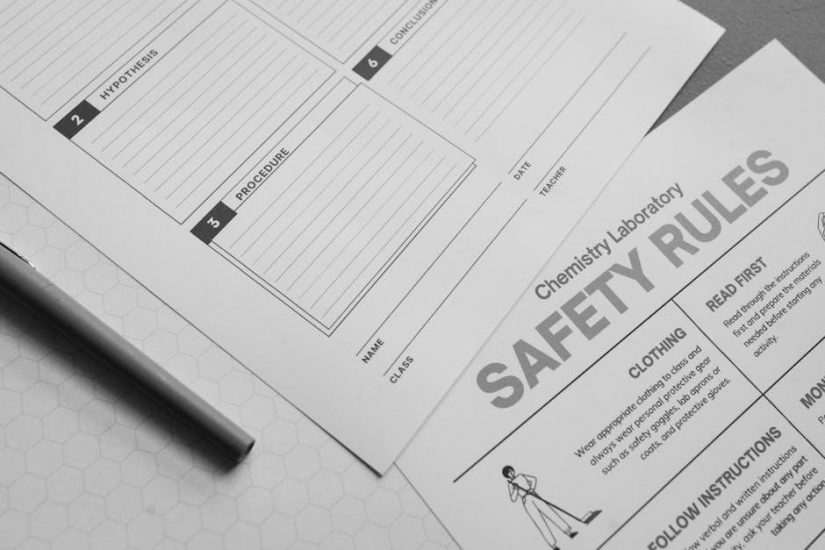Lab safety worksheets are interactive educational tools designed to teach students about proper lab safety protocols‚ equipment identification‚ and hazard recognition through engaging exercises and quizzes.
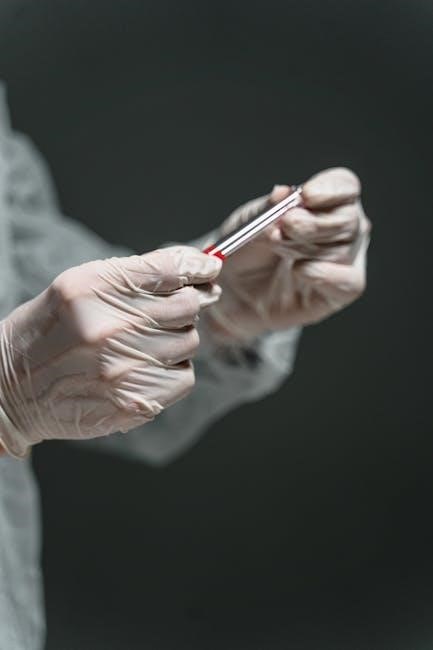
What is a Lab Safety Worksheet?
A lab safety worksheet is an educational tool designed to teach students about proper laboratory practices‚ safety protocols‚ and equipment usage. It typically includes exercises‚ quizzes‚ and scenarios to assess understanding. These worksheets are often available in PDF‚ PNG‚ or Google Apps formats‚ making them accessible for classroom or remote learning. They cover essential topics such as chemical handling‚ hazard recognition‚ and emergency procedures. By completing these worksheets‚ students demonstrate their knowledge of lab safety principles and prepare for hands-on activities. The interactive nature of these resources helps engage learners and reinforce critical safety habits. They are widely used in science and chemistry classes to ensure a safe and responsible learning environment. Lab safety worksheets are a key component of lab safety education.
Purpose of Lab Safety Worksheets
The primary purpose of lab safety worksheets is to educate students on safe laboratory practices‚ ensuring they understand proper protocols and procedures. These resources are designed to reinforce theoretical knowledge through practical exercises‚ quizzes‚ and real-life scenarios. They help students identify laboratory equipment‚ understand safety symbols‚ and recognize potential hazards. Worksheets also promote critical thinking and problem-solving skills‚ preparing students for hands-on lab activities. By completing these exercises‚ students demonstrate their ability to apply safety measures‚ reducing the risk of accidents. Additionally‚ lab safety worksheets serve as assessment tools for instructors to evaluate students’ understanding of safety principles. They are an essential component in creating a safe and responsible learning environment. Their interactive nature makes learning engaging and effective for all students.
Importance of Lab Safety Education
Lab safety education is crucial for preventing accidents‚ fostering a culture of safety‚ and ensuring compliance with legal and ethical standards in scientific environments.
Why Lab Safety is Crucial
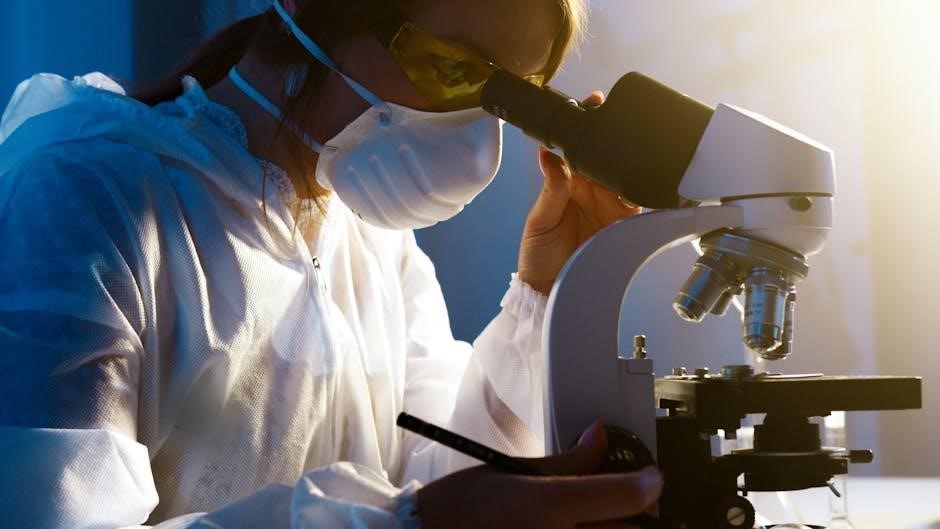
Lab safety is crucial for preventing accidents‚ protecting personnel‚ and ensuring legal compliance. It minimizes risks associated with hazardous materials and equipment‚ creating a secure environment for scientific exploration. Neglecting safety protocols can lead to severe injuries‚ legal liabilities‚ and environmental damage. By prioritizing safety‚ laboratories foster a culture of responsibility and awareness‚ essential for all participants. Proper training and adherence to guidelines help students and professionals understand potential hazards and adopt best practices. This not only safeguards individuals but also maintains the integrity of experiments and the laboratory setting. Lab safety education prepares individuals to handle emergencies effectively‚ making it a cornerstone of scientific education and professional conduct. Its importance cannot be overstated‚ as it directly impacts the well-being of everyone involved in lab activities.
Benefits of Using Safety Worksheets
Lab safety worksheets offer numerous benefits‚ including interactive learning experiences that enhance understanding of safety protocols. They provide structured exercises to familiarize students with laboratory equipment‚ symbols‚ and proper usage‚ fostering awareness and responsible behavior. Worksheets also serve as valuable tools for assessing knowledge retention through quizzes and scenario-based activities. By engaging students in hands-on tasks‚ they promote active learning and preparation for real-world lab scenarios. Additionally‚ these resources are easily accessible in formats like PDF‚ making them convenient for teachers and learners alike. Regular use of safety worksheets helps cultivate a culture of safety‚ ensuring that students are well-prepared to navigate laboratory environments confidently and responsibly.

Essential Lab Safety Guidelines
Adhering to lab safety rules‚ wearing protective equipment‚ and following proper chemical handling procedures are critical to minimizing risks and ensuring a secure laboratory environment for all participants.
General Safety Rules
General safety rules are essential guidelines that ensure a safe and secure laboratory environment. These rules include wearing appropriate personal protective equipment (PPE)‚ such as gloves and goggles‚ to protect against chemical spills and biological hazards. Proper handling and storage of chemicals‚ as well as adhering to fire safety protocols‚ are critical to preventing accidents. Students should also be aware of emergency exits‚ fire extinguishers‚ and first aid kits. Additionally‚ avoiding horseplay‚ keeping workspaces clean‚ and following instructions carefully are fundamental to maintaining a safe lab setting. These rules are often reinforced through lab safety worksheets‚ which provide interactive exercises to test understanding and compliance. By following these guidelines‚ students can minimize risks and ensure a productive learning experience.

Laboratory Equipment Safety
Laboratory equipment safety is a cornerstone of maintaining a secure and efficient working environment. Proper use and handling of equipment‚ such as microscopes‚ Bunsen burners‚ and centrifuges‚ are essential to preventing accidents. Students should familiarize themselves with each tool’s function and safety precautions‚ often through lab safety worksheets that include equipment identification exercises. Regular maintenance and calibration of equipment ensure optimal performance and minimize risks. Additionally‚ understanding electrical safety‚ avoiding overcrowded workspaces‚ and never leaving running equipment unattended are crucial practices. By adhering to these guidelines‚ students can effectively utilize laboratory equipment while safeguarding themselves and others. These principles are often reinforced through interactive quizzes and scenarios in lab safety educational materials.
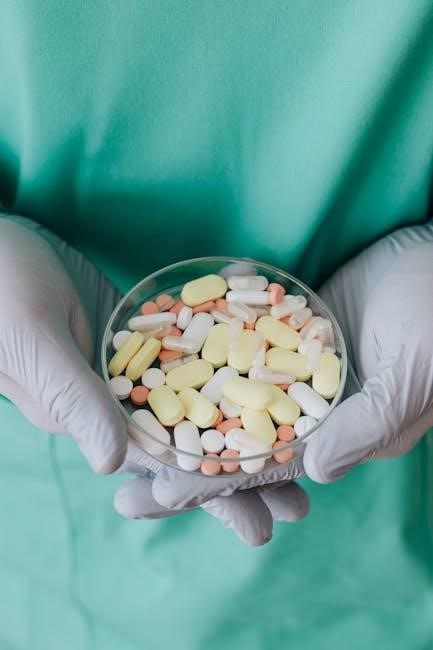
Lab Equipment Identification and Usage
Lab safety worksheets often include exercises for identifying and understanding the proper use of laboratory equipment‚ ensuring students can safely and effectively operate tools like microscopes and Bunsen burners.
Matching Equipment with Functions
Lab safety worksheets often include interactive exercises where students match laboratory equipment with their correct functions. This helps students develop a clear understanding of how each tool is used‚ ensuring safe and effective experimentation. For example‚ worksheets might ask students to pair items like microscopes‚ Bunsen burners‚ and thermometers with descriptions of their purposes. Such activities enhance familiarity with lab equipment and promote proper handling techniques. By reinforcing the connection between equipment and their functions‚ these exercises reduce accidents and improve efficiency in laboratory settings. They also serve as a foundational skill for students to apply in real-world scientific environments. This practice is essential for building confidence and competence in laboratory work.
Interactive Exercises for Equipment Familiarity
Interactive exercises in lab safety worksheets are designed to enhance students’ familiarity with laboratory equipment through engaging and practical activities. These exercises often include matching games‚ fill-in-the-blank questions‚ and image-based identification tasks. For example‚ worksheets may ask students to identify equipment from images or descriptions‚ ensuring they understand the purpose and proper use of each tool. Such exercises not only improve equipment recognition but also reinforce safe handling practices. They encourage active learning‚ making complex concepts more accessible and memorable. By incorporating visual and hands-on elements‚ these exercises prepare students for real-world laboratory environments‚ helping them feel confident and prepared when working with equipment. This approach is essential for fostering a safe and efficient lab experience.
Understanding Lab Safety Symbols and Signs
Lab safety symbols and signs are crucial for conveying essential safety information in laboratory settings‚ ensuring safe practices and preventing potential hazards through clear visual communication and education.
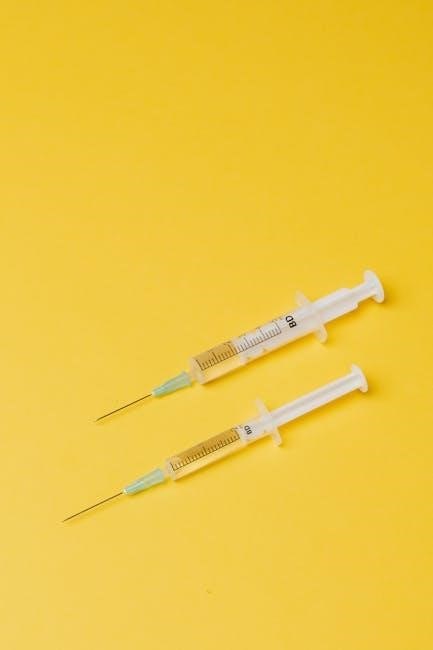
Common Symbols and Their Meanings
Lab safety symbols are standardized visuals that communicate critical safety information. Common symbols include the biohazard sign‚ indicating biological hazards‚ and the radiation warning‚ signaling radioactive materials. The flame symbol denotes flammable substances‚ while the corrosion symbol alerts to caustic materials. The skull and crossbones represent toxic substances‚ and the explosion symbol warns of reactive or explosive materials. These symbols are universally recognized and are essential for preventing accidents and ensuring compliance with safety protocols in laboratories. Understanding their meanings is crucial for safe handling of materials and equipment‚ making them a fundamental part of lab safety education and training programs.
Importance of Recognizing Symbols
Recognizing lab safety symbols is vital for ensuring a safe working environment. These symbols act as quick visual reminders of potential hazards‚ enabling individuals to take appropriate precautions. They are particularly important in emergency situations where time is critical. Understanding symbols prevents accidental exposure to harmful substances‚ reduces the risk of injuries‚ and promotes adherence to safety protocols. Moreover‚ familiarizing oneself with these symbols fosters a culture of safety and accountability in the laboratory. Regular training and the use of worksheets can enhance symbol recognition‚ ensuring that everyone in the lab is prepared to respond safely and effectively to various situations.
Lab Safety Scenarios and Case Studies
Lab safety scenarios and case studies provide real-life examples of incidents‚ enabling students to analyze risks and develop practical solutions for maintaining a safe laboratory environment.
Safety Scenario Analysis
Safety scenario analysis is a critical component of lab safety education‚ allowing students to engage with real-life incidents and practice decision-making. Worksheets often present hypothetical or historical lab incidents‚ prompting students to identify potential hazards‚ outline proper protocols‚ and propose solutions. These exercises encourage critical thinking and problem-solving skills‚ preparing students for unexpected situations. Interactive questions‚ such as true/false or multiple-choice‚ may accompany scenarios to reinforce understanding. Case studies from actual lab accidents further enhance learning by illustrating consequences of safety lapses and best practices to prevent them. By analyzing these scenarios‚ students develop a deeper appreciation for lab safety and improve their ability to respond appropriately in emergencies.
Case Studies and Group Discussions
Case studies and group discussions are effective tools for reinforcing lab safety concepts‚ fostering collaboration‚ and enhancing critical thinking. Worksheets often include real-life scenarios or historical lab incidents‚ encouraging students to analyze what went wrong and how to prevent similar situations. Group discussions allow students to share perspectives‚ debate solutions‚ and learn from one another. These activities promote active learning and help students connect theoretical knowledge with practical applications. By examining case studies‚ students gain insights into the consequences of safety protocols being ignored and the importance of adherence. This collaborative approach ensures a deeper understanding of lab safety principles and prepares students for real-world laboratory environments.

Quizzes and Assessments for Lab Safety
Quizzes and assessments are crucial for evaluating students’ understanding of lab safety. Worksheets often include true/false and multiple-choice questions‚ testing knowledge of signs‚ protocols‚ and equipment. These tools reinforce learning and identify areas needing improvement‚ ensuring a safer lab environment.
True or False Questions
True or false questions are a popular format in lab safety worksheets‚ designed to test students’ understanding of key safety protocols. These questions cover essential topics such as the proper use of personal protective equipment (PPE)‚ handling of hazardous materials‚ and emergency procedures. For example‚ “True or False: Lab gloves should always be worn when handling chemicals.” Such questions help students identify gaps in their knowledge and reinforce critical safety practices. They are often paired with explanations for correct answers‚ providing immediate feedback and fostering better retention of safety guidelines. This format is effective for quick assessments and ensures students are well-prepared for lab environments.
Multiple-Choice Questions
Multiple-choice questions in lab safety worksheets are an effective way to assess students’ understanding of safety protocols‚ equipment usage‚ and emergency procedures. These questions present several options‚ requiring students to select the correct answer. For instance‚ “What should you do if you spill a chemical on your skin?” with options like “Wash with soap and water” or “Use a fire extinguisher.” This format challenges students to apply their knowledge critically. Worksheets often include explanations for correct answers‚ enhancing learning outcomes. Multiple-choice questions are ideal for comprehensive assessments‚ ensuring students grasp essential safety practices before engaging in hands-on lab activities‚ thus promoting a safer learning environment. They are widely used in educational settings to evaluate preparedness for laboratory work.
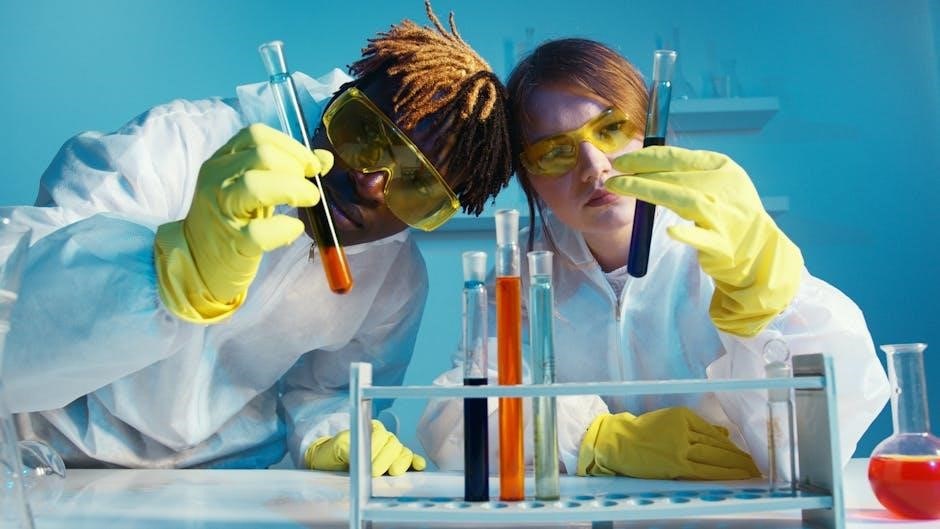
Best Practices for Maintaining Lab Safety
Best practices include following established protocols‚ using personal protective equipment‚ and ensuring proper handling of chemicals and lab equipment to prevent accidents and ensure a safe environment.
General Safety Tips
General safety tips include wearing appropriate personal protective equipment‚ reading safety labels‚ and following proper procedures for handling chemicals and equipment. Always ensure good ventilation and keep emergency exits clear. Familiarize yourself with the location of safety equipment like fire extinguishers and eyewash stations. Never eat or drink in the lab and avoid distractions while conducting experiments. Keep work areas clean and organized to prevent accidents. Pre-plan experiments and dispose of waste properly. Stay alert and report any hazards or incidents immediately. These practices help create a safe and efficient laboratory environment for everyone.
Specific Safety Protocols
Specific safety protocols vary by lab activity but often include detailed procedures for handling hazardous materials and equipment. For chemicals‚ this involves wearing gloves‚ goggles‚ and lab coats‚ as well as understanding proper storage and disposal methods. When using equipment like Bunsen burners or microscopes‚ students must follow operational guidelines strictly. Emergency procedures‚ such as spill cleanup or fire response‚ should be practiced regularly. Additionally‚ biological safety protocols require proper handling of specimens and sterilization of tools. Adhering to these specific protocols ensures that laboratory activities are conducted safely‚ minimizing risks to students and equipment. These protocols are often outlined in lab safety worksheets to reinforce their importance and ensure compliance.
